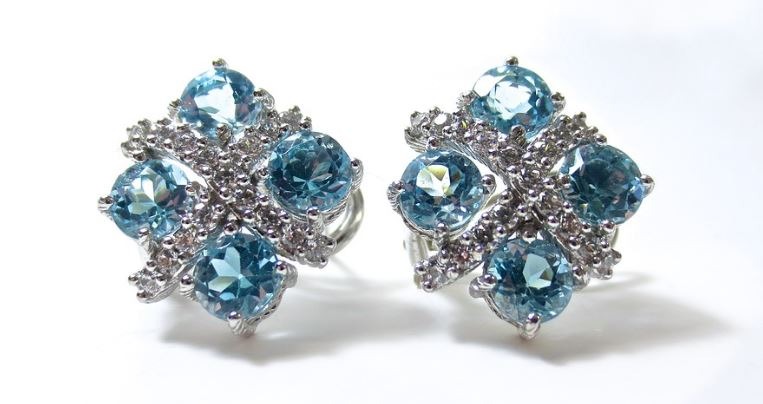Both in ancient and modern times, wearing aquamarine is thought to have a variety of positive effects on the wearer. Because it goes with any color and enhances the wearer’s beauty, it is one of the most significant stones in the jewelry industry.
Find out more about the incredible aquamarine and its various jewelry applications in this article.
What are Aquamarines?
The term “Aquamarine” is used to describe gem-quality beryl specimens that range in color from greenish blue to blue; therefore, it’s no surprise that people think of water when seeing this light blue stone. It is derived from two Latin words: aqua, meaning “water,” and marina, meaning “of the sea.”
Beryl is a silicate mineral that is relatively uncommon and can be found in igneous and metamorphic rocks all over the world. Beryl has been a minor beryllium ore, and color variations of the mineral are among the most well-liked gemstones in the world. The most well-known beryl varieties are emerald (intense green color), aquamarine (blue-green color), heliodor (rarer yellow variety), and morganite (rarer peach-pink variety).
Aquamarines range in color from stones with a rich, vibrant color to stones that are very light, almost imperceptible. The majority of Aquamarine has a very light color, which can be almost undetectable in very small stones. The most common stones are those with deep blue coloring. They are also the most expensive and scarce.
Durability
One of the more durable gemstones, Aquamarine has a Mohs hardness between 7.5 and 8. The only well-known gemstones that are significantly harder are chrysoberyl, topaz, sapphire, ruby, and diamond.
Aquamarine and its Brief History
Aquamarine has a rich maritime folklore in Western cultures because of its color and name. It has historically been used to safeguard sailors, fishermen, and travelers in general. The Greeks believed it provided safe and prudent passage across choppy seas, while the Egyptians loved the blue tones and thought it was a stone given as a gift as a symbol of happiness. Many people thought it was a talisman or offering that helped bring rain to dry lands, an antidote to poison, a mermaid’s spell, a spell from an oracle, or an antidote to poison.
What is Aquamarine used for?
It is believed that Aquamarine represents happiness and youth. When used in meditation, Aquamarine and other heart-related crystals like rhodonite, green opal, rose quartz, pink halite, chrysocolla, and green calcite are believed to have a synergistic effect that speeds up heart healing. Additionally, the stone is reputed to improve intellect, bring about mental clarity, calm an overactive mind, and aid in sorting through energy and information.
Aquamarine and Jewelry
For collectors of mineral specimens, Aquamarine crystals are especially valuable due to their large size, relative cleanliness, and well-formedness. Translucent Aquamarine is often cut into beads and sometimes cut as cabochons. Now, a “cabochon” is a gemstone that has been cut, polished, and shaped as opposed to being faceted. A convex (rounded) obverse and a flat reverse are typical features of the final product.
Due to its popularity, Aquamarine can be found in almost all jewelry stores in the United States. It is a highly valued gem that can be used to make a variety of jewelry, including Aquamarine rings, lapel pins, earrings, necklaces, and bracelets. Prices on Aquamarines can vary widely, so it is important to understand the quality factors that affect price. Like all gemstones, the “four C’s” — color, clarity, carat weight, and cut — affect price and value. But in the case of Aquamarine, color is especially important.
The price of Aquamarine crystal averages $675 per carat for a cut and polished gemstone suitable for rings and other jewelry. However, for less than $100, it is easy to find small, unpolished or polished Aquamarine crystals that are suitable for precise feng shui placement. Online vendors charge several hundred dollars for larger, fist-sized pieces of high-quality rough Aquamarine mineral with a distinctive blue color.
Where can Aquamarine be found?
For more than a century, Brazil has been the primary supplier of gem-quality Aquamarine in the world. Both pegmatites and alluvial deposits can be found there. Aquamarine can also be found in Afghanistan, Australia, China, India, Kenya, Madagascar, Malawi, Mozambique, Myanmar, Namibia, Nigeria, Pakistan, Russia, Tanzania, the United States, Vietnam, and Zambia.
For those who may not be familiar with the terms alluvial deposits and pegmatites, the former actually refers to soils deposited in riverbeds, whereas the latter refers to extreme igneous rocks that form during the final stage of a magma’s crystallization. This type of igneous rock contains minerals that are uncommon in other types of rocks, as well as exceptionally large crystals.
How to spot a real Aquamarine
A genuine Aquamarine stone can most easily be distinguished by its color. As stated above, they are a light blue hue, resembling seawater, in their natural state. They could also be slightly tinted yellow or green. Unlike their cousin gemstone, the Emerald, the best Aquamarine is “clean” and devoid of discernible inclusions. Excellent transparency and clarity give Aquamarine gemstones a beautiful shine.
Interesting Facts about Aquamarine
- Aquamarine is the birthstone for March. Also, it is considered the 19th wedding anniversary gemstone, as it is believed to strengthen a marriage and calm turbulent waters.
- The rectangular 1,298-carat Roosevelt Aquamarine, which was presented to Eleanor Roosevelt and her husband, former President Franklin D. Roosevelt, when they visited Rio de Janeiro in 1936, is one of the most well-known Aquamarines.
- The Smithsonian Institutions hold the world’s largest cut Aquamarine, the Dom Pedro, a 10,363-ct carved obelisk. It was carved out of a crystal that was more than 3 feet (0.91 m) long and weighed about 100 pounds (45 kg) at its original size. Around 1980, a mine in Pedra Azul, Minas Gerais, Brazil, yielded the stone, which was given the names Pedro I and Pedro II in honor of the Brazilian emperors.
- Aquamarine is the Colorado state gemstone. The state of Colorado has a long mining history, and Aquamarine is mined on Mt. Antero, a 14,00-foot peak close to Buena Vista in the center of the state.
- This gemstone was once believed to give its wearers protection during battle or in litigation.
Conclusion
Truly, Aquamarine is one of the best pieces one can add to their own arsenal of jewelry. Aside from its more affordable prices when compared to other stones, Aquamarine can equally be alluring and mesmerizing in appearance and can undoubtedly make a lasting impression as a jewelry piece.

